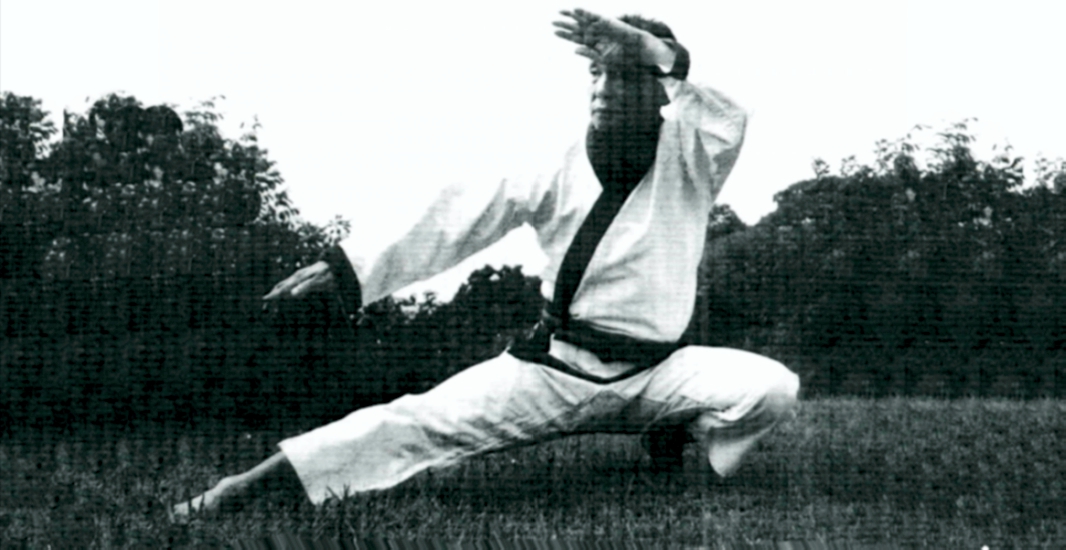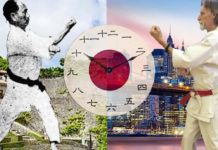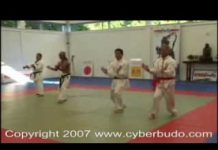Hwang Kee, founder of Tang Soo Do, claimed to have brought the art’s Pyong Ahn forms back from China in the 1930s. That was the premise that author John Hancock set out to investigate more than 14 years ago.
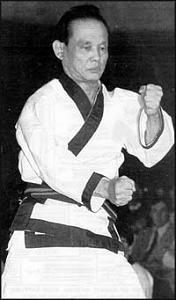
Hwang Kee, Founder of Tang Soo Do.
By John Hancock ~ I first met Han Chi Sup in August 1984. He was practicing in the Trent Gymnasium on Yongsan Army Post in Seoul, South Korea. I remember standing in the archway leading into the gym. To my left another master led a small group of students through the intricacies of some hapkido techniques. To my right, alone and absorbed in his own efforts, Han immersed himself in the execution of a rather long and intricate series of movements. His motions were filled with power, yet they were fluid and sinuous. I knew there was pattern and purpose to his dance.
My prior training in shorin-ryu karate allowed me to recognize Han’s exercise as a kata. To Koreans, it was known as a hyung. Han’s performance held me mesmerized as he whirled first one way, then another. What so strongly captivated me was that the form was punctuated with powerful focal points yet was distinctly circular in overall design. Because I had previously been exposed to the Chinese martial arts, I recognized it as being of Chinese origin, yet never had I seen such a clear demonstration of power by anyone performing a similar routine. I would later learn that the hyung (form) was known as So Rim Jang Kwon (Shaolin long fist).
Following that performance, Han executed three of the five pinan kata, with which I was familiar because of my karate background. During our subsequent conversation, he explained that those hyung were known as Pyong Ahn forms, which means “peace.”
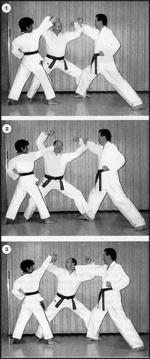
From that initial meeting, I set upon a path that I would maintain for more than 12 years. The journey has been more than just a series of physical accomplishments, more even than an education or a learning experience. The quest has gone beyond a mere search for a holy grail of technique or knowledge. It has been a sacrifice of myself to the task of seeking, knowing and understanding Tang Soo Do, the “China hand way.”
The photo on right shows the myth of the two-man block: The Pyong Ahn Eedan form includes a movement that is often described as a block against two punches, one from an opponent standing to the front and the other from an opponent standing to the side (1). In reality, however, chances are slim that a martial artist could successfully defend himself against this kind of simultaneous attack (2-3)
The Start
Forms have always held a special interest for me. No matter what art seized my imagination, I always embraced a sincere affection for its forms. Among the striking arts, forms are elaborate series of movements linked together. They are performed solo, incorporating rhythm, points of focus and patterns of repetition. A form done with a partner is often classified as il soo sik dae ryun (one-step fighting) or ho shin sool (self-defense technique).
My initial training in Tang Soo Do included the study of classical forms. Most schools still utilize such forms as a criterion for evaluating a student’s progress. The first forms I learned were of the ki cho (foundation) series. Next were the pyong ahn series. When I asked how Tang Soo Do came to include these forms, I was told that Hwang Kee, founder of the art, brought them back from China, where he had studied in his youth.
This answer perplexed me, as I had always been told the pinan series were of Okinawan origin. Yet every Tang Soo Do master I’d ever met gave me the same answer: “Hwang Kee brought the Pyong Ahn Hyung back from China.” How could this be so?
Pyong ahn is the Korean pronunciation for the Chinese characters associated with the forms. They were created in 1901 by Itosu Yasutsune, a shorin-ryu karate master in Okinawa. The Okinawan dialect pronounces these characters as “pinan.” Itosu himself was an educator who believed that karate practice was an excellent method by which young people could strengthen their body while building good character. During Itosu’s early life, karate was still very much a secret practice carried out by small groups of initiates. The training was somewhat brutal, and the forms were rather complex.
Originally, all shorin-ryu students began by learning the form Seisan (Korean: ship sam soi), which refers to the “13 powers” of five elements and eight directions. That form is one of the longest of the classical forms. Itosu did not believe that young people should be taught the deeper secrets of karate until they had successfully proved themselves over a period of years to be of sound moral character. He also believed it would be dangerous to teach children the devastating strikes hidden within the art. Hence, the pinan series was created by drawing from two older forms: Kusanku (Korean: kong sang koon) and chiang nan (Korean: jae nam). Five forms were created and introduced into Okinawa’s public schools as instruction for children at the elementary-school level. From 1905 to 1909, one form was introduced each year.
In time another Okinawan, Funakoshi Gichin, would travel to Japan and teach a version of these forms, eventually renaming them heian. Other former students of Itosu, such as Mabuni Kenwa (founder of shito-ryu karate), would also relocate to Japan and teach versions of the pinan kata. (As an interesting sidebar, Japanese karateka switched the order of the first two forms. Hence, anyone who trains in a traditional
Okinawan school knows them in the original order, while those who trace their lineage through a Japanese school have pinan No. 2 as their version of pinan No. 1, and vice versa. Tang Soo Do practitioners need to take note here as their order is the same as used by the Japanese schools.) That series eventually made its way into Korea via such notable practitioners as Lee Won Kuk (the chung do kwan school), Choi Hong Hi (the oh do kwan school), Yoon Byung In (the chang moo kwan school) and Ro Byung Jik (the song moo kwan school)-all of whom studied in Japan. Such is the history of the Pyong Ahn Hyung.
Yet the question remained: How did Tang Soo Do end up with this series of forms? The rhetoric was always the same: “Hwang Kee brought them back from China.” This answer could not be true … or could it?
The Confrontation
Tang Soo Do’s Pyong Ahn forms (demonstrated by the art’s founder, Hwang Kee) closely resemble karate’s Pinan forms, John Hancock claims.
Pyong Ahn and Pinan both mean “peace.”
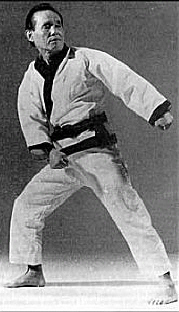
I once asked that question directly of Hwang Kee’s son, Hwang Hyun Chu, director of the United States Tang Soo Do Moo Duk Kwan Federation. The answer was the standard one: “My father brought [them] back from China.” I pressed the point, saying that this simply could not be true. The forms were not Chinese; they were Okinawan in origin. The fact that this was common knowledge to students of Japanese and Okinawan karate had led to more than one rumor that Hwang Kee had traveled to Japan or Okinawa and learned the forms there. One myth even claimed that he had spent a few months in Okinawa studying shorin-ryu and goju-ryu karate. When I pursued the issue, Hwang Hyun Chul politely thanked me for calling and said good-bye.
I later called the federation headquarters to say that I would not be renewing my membership because my questions were not being answered seriously. This led Hwang Hyun Chul to ask specifically what I wanted to know. I brought up the Pyong Ahn Hyung and their history. What occurred during this conversation has troubled me for 10 years.
When Hwang told me that his father had brought the Pyong Ahn Hyung to Korea back after studying in China, it incensed me that he would insult my intelligence. I had made it clear through many earlier correspondences that I had extensively studied the history of those forms. For Hwang to simply feed me rhetoric was a slap in the face, and I reacted accordingly. I confronted him directly with the facts-documented and incontrovertible facts that were even alluded to by the grandmaster himself. In 1978 Hwang Kee published Tang Soo Do (Soo Bahk Do). On page 372 he elaborated on the Pyong Ahn Hyung as follows: “Originally this form was called jae nam. Approximately 100 years ago an Okinawan master, Mr. Idos, reorganized the jae nam form into a form closely resembling the present pyong ahn forms.”
It was after my outburst that Hwang Hyun Chul had told me in so many words to have a nice life. Hwang did not rebut my statements, nor did he confirm any of them. He did not explain how Tang Soo Do had come to include the forms. I felt as though I was the one who had been insulted, yet Hwang had hung up on me.
During my time in Korea, I had heard of something called kibun, but I did not gain a real grasp of it until nearly a decade later. Kibun has no English equivalent, but it is often translated as “face.” I had heard how Asians “gain” or “lose” face, and this often holds serious consequences. I used to equate face with pride, but kibun is much more complex than that because it also refers to one’s emotional state of being.
My exchange with Hwang Hyun Chul was an exercise in ruining kibun. My kibun had been disturbed when Hwang answered me in an insulting manner, and I had disturbed his when I accused him of not being honest with me.
That incident caused me to go off on my own search for the facts. That journey has been fraught with frustrations and dead ends. Yet for some strange reason I, as an outsider, was able to piece together a series of unanswered questions that have plagued Tang Soo Do practitioners for at least 30 years.
The Search
In 1995 I attended a regional gathering of Tang Soo Do black belts. During a discussion with one talented young man, I was told that the black belts in his organization were taught that the pyong ahn series was created by Hwang Kee and Funakoshi Gichin. The story goes that Funakoshi and Hwang traveled to China with other martial arts masters, where they studied the Chinese arts. Together they created the pyong ahn forms, and then each returned to his respective country and taught his own version.
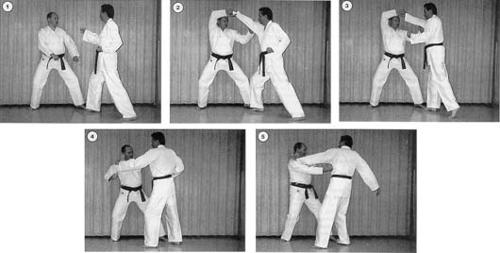
In the photo above we see the probable truth about the two-man block. It is more likely that the doubleblock technique from the Pyong Ahn Eedan form was designed to be used against a single opponent. As the opponent (right) steps in to strike (1) John Hancock uses a high block to deflect the punching arm and an uppercut to strike under the same arm. (2) The opponent then steps forward to punch. (3) Hancock blocks the strike with his left arm. (4) Hancock then follows through with an inverted punch to the ribs (5).
This story could have gone unchallenged indefinitely as long as the black belts in that organization never questioned its validity and continued to repeat it to younger generations. But a simple fact check quickly proved it to be a fallacy.
First, while Hwang Kee did travel to China, there is no indication he was part of a group of karate masters. Second, Funakoshi never traveled to China; he was an Okinawan who relocated to Japan, where he lived out his life. Third, Hwang and Funakoshi were not contemporaries in the sense that the story implies. Funakoshi was born in 1868. In 1927 he relocated to Japan, where he remained until his death in 1957. Hwang was born in 1914 just north of Seoul. In 1935, following completion of high school, Hwang traveled to China as part of his job and remained there until 1937. By this time, Funakoshi was 70 years old, while Hwang was only 24. That would hardly make them contemporaries.
Nonetheless, some people have perpetuated the rumor that Hwang Kee studied under Funakoshi at his shotokan karate school. As far as I have been able to discover, Hwang and Funakoshi never trained together, nor even ever met each other.
The Alternatives
Then how did Tang Soo Do come to include the Pyong Ahn Hyung in its curriculum? One possible explanation is that Hwang picked up the forms in his youth from Japanese karateka in Korea. This is entirely possible, as more than a few Japanese military men in Korea at that time had skill in karate and a knowledge of the pinan (or heian) kata.
Another possibility is that Hwang learned the forms from Koreans who had studied in Japan. Again, this is plausible, yet not likely. The majority of Koreans who had trained in Japanese karate did not return to Korea until after liberation in 1945. The exception was Lee Won Kuk, who is reputed to have operated a dojang (school) in Korea as early as 1933. If this is true, it would have allowed for a three-year window of opportunity prior to Hwang’s exodus to China in 1935.
Both of these are reasonable theories. However, I developed a third possible explanation which tied up all the loose ends rather nicely.
To borrow the words of Sherlock Holmes, “Whenever all theories have been excluded, what remains, no matter how implausible, must in fact be the truth.” Such is the credo of deductive reasoning. With this in mind, I was drawn again to examine the assertion that Hwang Kee did indeed bring the pyong ahn forms back from China.
Hwang Kee had once stated that he was a personal friend of Yamaguchi Gogen. Yamaguchi, a proponent of Japanese goju-ryu karate, was a student of Mabuni Kenwa, founder of shito-ryu karate. Mabuni was a student of Itosu Yasutsune, creator of the pinan kata. Also of note is that Hwang Kee mentioned Mabuni in his 1978 book Tang Soo Do (Soo Bahk Do). Additionally, Yamaguchi was an intelligence officer with the Japanese army during World War II and was stationed in Manchuria. Hwang was also in Manchuria during this time. Hwang himself admitted in a 1991 interview that he did not begin serious martial arts training until he started working for the Japanese railroad in Manchuria. Therefore, it is possible that Hwang learned the Pyong Ahn Hyung-and perhaps the majority of Tang Soo Do forms-from Yamaguchi while in Manchuria between 1935 and 1937. This theory is supported by the similarities of the pinan series as practiced in shito-ryu karate, whose founder was a direct student of the forms’ creator.

In the photo on the right, author and researcher John Hancock, is performing a technique from the Pyong Ahn Cho Dan form. He has practiced Tang Soo Do for more than 14 years.
If this theory is accurate, Hwang Kee could indeed have brought the Pyong Ahn Hyung back from China. Remember that this is the original premise that I had been looking to verify-and that the Moo Duk Kwan had for 50 years insisted was the truth. The strength and failing of this theory is that it could be proved or disproved only by Hwang Kee himself. The answers to this and many other questions lay in Hwang Kee’s latest book The History of Moo Duk Kwan (1995).
On pages 15 and 16 of that text, it clearly states that Hwang Kee’s knowledge and understanding of the majority of the forms taught within Tang Soo Do, including the Pyong Ahn Hyung, came from reading and studying Japanese books on Okinawan karate. Hwang discovered those books in the library of the train station where he worked in Seoul in 1939. We can only speculate as to which books those were, but I would venture that Funakoshi’s Ryukyu Kempo Karate (1922) was among them.
Bitter Fruit
Nonetheless, my original argument that the forms are Okinawan, not Chinese, and that Hwang did not learn them in China, was now substantiated. However, I would have been happier to have discovered that Hwang had at least learned the forms from Japanese karateka while in China. Unfortunately, this was not the case. It was a bit disappointing to find out that the grandmaster’s only knowledge of and experience with the forms came from books.
When I first drafted this article, I did so with the hypothesis that the Pyong Ahn Hyung may indeed have been brought to Korea from China by Hwang Kee. I even used deductive reasoning in an examination of all available information to support that argument. It is something of a bitter coincidence that as I was concluding my years of research and preparing to put pen to paper, Hwang Kee published his latest book and in it admitted that he had not learned the forms in China at all, but from studying Japanese karate books in Korea. Prior to reading this book, I was considering phoning Hwang Hyun Chul to apologize for my accusations during the aforementioned conversation of 1986. However, I obviously was correct in my assumptions.
I am not opposed to the Soo Bahk Do Association or what it hopes to accomplish in terms of bringing soo bahk do back from extinction. Both it and Tang Soo Do are excellent martial arts that offer as many benefits to their students as any other style in existence. I just believe that questions from practitioners-no matter the art-should be answered intelligently and honestly.
About The Author
John Hancock is a LaGrange, Kentucky based free-lance writer and Tang Soo Do practitioner.

